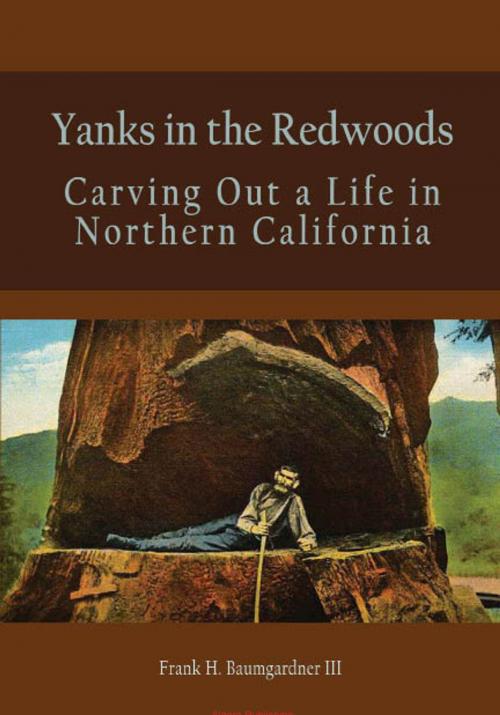Yanks in the Redwoods
Carving Out a Life in Northern California
Nonfiction, History, Americas, United States, State & Local| Author: | Frank H. Baumgardner III | ISBN: | 9780875868035 |
| Publisher: | Algora Publishing | Publication: | December 15, 2009 |
| Imprint: | Algora Publishing | Language: | English |
| Author: | Frank H. Baumgardner III |
| ISBN: | 9780875868035 |
| Publisher: | Algora Publishing |
| Publication: | December 15, 2009 |
| Imprint: | Algora Publishing |
| Language: | English |
Yanks in the Redwoods tells the story of the exploration and settlement of the Northwest, focusing on a one-hundred-mile region of the Mendocino Coast, 70 miles north of San Francisco.
Covering the period of 18001900, the book presents several never-before-published accounts by participants.
The founders of the Humboldt Bay Community are seen through the eyes of George Gibbs, Customs Collector, Astoria, OR. A unique look at the Oregon Trail, derived from the notes jotted down by Jesse Applegate and Stanley and Clarissa Taylor, debunks the Hollywood image of the hostile Indian.
Sparely-written diary entries convey the pungent flavors and kernels of wisdom squeezed out of a life of hard work in a family timber business and the almost speechless surprise when corporations quickly moved in and muscled the founders out of their own enterprises.
The book contains personal accounts by John Work, leader of the Hudson Bay Co. Expedition to the North Coast, and by Jerome and Emily Ford, founders of the Mendocino Lumber Co., and the fraud investigation of Thomas J. Henley. It tells of the founding of Mendocino and Ft. Bragg, the experiences of the Chinese community, the role of Dog Hole schooners, and the opium trade.
The book concludes with excerpts from the diary of Etta Stephens Pullen, a pioneer who relocated from Maine to Little River, California, and the transcript of an interview with Lucy Young, a Wailaki-Lassik Indian telling the grim story of genocide that was going on coincidental with events in Etta Pullens diary.
Never before has this coastal segment of Northern California been studied in a comprehensive historical book. All of the earliest participant groups, Indians, Yankees and immigrants from the Midwestern and Southern states, northern European immigrants and Chinese, are presented. Wherever possible excerpts from primary sources, written by the people who made this history, are directly quoted. This work will become an example for other Northwest coastal regions to tell their own stories for later generations to enjoy.
Yanks in the Redwoods tells the story of the exploration and settlement of the Northwest, focusing on a one-hundred-mile region of the Mendocino Coast, 70 miles north of San Francisco.
Covering the period of 18001900, the book presents several never-before-published accounts by participants.
The founders of the Humboldt Bay Community are seen through the eyes of George Gibbs, Customs Collector, Astoria, OR. A unique look at the Oregon Trail, derived from the notes jotted down by Jesse Applegate and Stanley and Clarissa Taylor, debunks the Hollywood image of the hostile Indian.
Sparely-written diary entries convey the pungent flavors and kernels of wisdom squeezed out of a life of hard work in a family timber business and the almost speechless surprise when corporations quickly moved in and muscled the founders out of their own enterprises.
The book contains personal accounts by John Work, leader of the Hudson Bay Co. Expedition to the North Coast, and by Jerome and Emily Ford, founders of the Mendocino Lumber Co., and the fraud investigation of Thomas J. Henley. It tells of the founding of Mendocino and Ft. Bragg, the experiences of the Chinese community, the role of Dog Hole schooners, and the opium trade.
The book concludes with excerpts from the diary of Etta Stephens Pullen, a pioneer who relocated from Maine to Little River, California, and the transcript of an interview with Lucy Young, a Wailaki-Lassik Indian telling the grim story of genocide that was going on coincidental with events in Etta Pullens diary.
Never before has this coastal segment of Northern California been studied in a comprehensive historical book. All of the earliest participant groups, Indians, Yankees and immigrants from the Midwestern and Southern states, northern European immigrants and Chinese, are presented. Wherever possible excerpts from primary sources, written by the people who made this history, are directly quoted. This work will become an example for other Northwest coastal regions to tell their own stories for later generations to enjoy.















